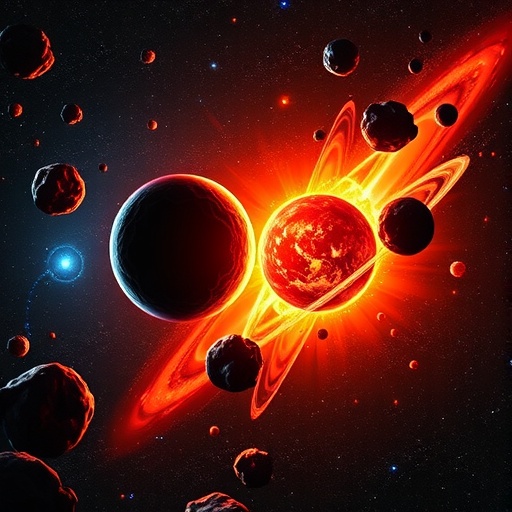Asteroids are fascinating remnants from the early solar system, providing invaluable insights into its formation and evolution. Approximately 4.6 billion years ago, our solar system emerged from a massive disk of gas and dust revolving around the Sun. Today, asteroids serve as some of the most complete remnants of that primordial material, akin to scavenged bits from a colossal construction site. Researchers have the incredible opportunity to analyze these celestial bodies, investigating their composition and surface properties, allowing us to reconstruct the conditions that prevailed during the solar system’s infancy.
A recent study, co-authored by scientist Joe Masiero of IPAC, highlights the intriguing link between two distinct asteroid types: metal-rich M-types and K-types, which contain a mix of silicates and other materials. Though their compositional differences seem vast, evidence suggests that both categories share a unique surface feature — a dusty layer rich in troilite, an iron and sulfur mineral. This finding could revolutionize our understanding of the relationships between different asteroid classes and their origins.
Masiero emphasizes the significance of asteroids as time capsules, offering us a glimpse into the formative stages of our solar neighborhood. Unique materials found on these celestial bodies serve as fingerprints that connect disparate asteroid types. Troilite, being a rare mineral, acts as a crucial identifier for linking M- and K-type asteroids, ultimately suggesting they may have emerged from similar parent bodies. This revelation opens up new avenues for asteroid classification and understanding their shared histories.
In classifying asteroids, researchers often utilize spectral analysis, with surface light reflection revealing chemical compositions. The classifications rely on letters, such as M for metal-rich asteroids and K for those dominated by silicates. However, the physical characteristics influencing these spectra are far more complex than they initially appear. Asteroids move constantly through space, their positions in relation to the Sun and Earth altering their apparent phases and affecting how scientists interpret their surface composition.
The phase angle — the geometrical relationship between the Sun, asteroid, and Earth — is a crucial factor determining how light reflects off these bodies. Just as the Moon exhibits distinct phases, asteroids exhibit variations in brightness and color based on their orientation to the Sun. Researchers like Masiero aim to unveil deeper truths about these objects by examining the interplay of materials present on their surfaces and how this varies with changing phase angles.
To probe these hidden characteristics, Masiero adopted an innovative approach using polarization, especially in the near-infrared spectrum. By assessing the polarization of reflected light from both M- and K-type asteroids, he reveals their fundamental connection through asteroids’ surface mineralogy. Light behaves differently depending on the material it interacts with, and by measuring this distinctive polarization response, researchers can assess asteroids’ surface compositions beyond traditional spectral analysis.
This groundbreaking methodology reveals substantial variations in polarization as the phase angle alters. These changes are fundamentally tied to the surface material’s diverse composition and structure, providing new perspectives on previously established classifications. Traditional methods might overlook critical insights, but polarization analysis offers a richer view of the asteroids’ mineralogies and helps distinguish their unique characteristics.
Masiero conducted this research using the WIRC+Pol instrument at Caltech’s Palomar Observatory, situated in the picturesque mountains above San Diego, California. The capabilities of this instrument are unparalleled, enabling astronomers to gather substantial infrared polarization data that no other telescope can match. Masiero’s collaborative experiences at Palomar underscore the importance of teamwork and expertise in gathering high-quality data, ultimately contributing to new scientific discoveries.
The crux of Masiero’s findings is that both M- and K-type asteroids exhibit significant similarities in their dusty troilite surfaces. This discovery suggests that these seemingly distinct categories of asteroids likely originated from the same types of larger progenitor bodies. As Earth possesses varying layers — core, mantle, and crust — these asteroids may represent material from different layers of larger celestial formations that fragmented over time.
Despite the different compositions of M- and K-type asteroids, the shared presence of troilite links these bodies in a way that challenges previous understanding. It raises questions about the processes that led to their respective forms and the conditions that may have influenced their evolution during the ancient collisions that shaped our solar system.
Asteroids serve as time capsules, offering glimpses into our solar system’s formative years and allowing researchers to piece together its complex history. By continuing to study these remnants with new techniques, scientists like Masiero aim to unravel the origins of our rocky companions in space and better understand the dynamic influences that shaped our planetary neighborhood.
As more groundbreaking discoveries emerge from asteroid research, our understanding of the solar system will evolve, shedding light on both our past and potential futures. Each study not only brings clarity to the nature of asteroids but also opens the door to further inquiries about planetary formation and the intricate tapestry of cosmic events that led to the formation of Earth and its neighbor planets.
Furthermore, this research in the field of planetary science demonstrates the interplay of advanced observational techniques and innovative methodologies, contributing to a robust knowledge base for both current and future space explorations. The study of asteroids is far from merely academic; it has profound implications for our understanding of the solar system, the evolution of planetary bodies, and perhaps the origins of life itself.
Through the lens of Masiero’s work, we gain insights that elevate our perspective on these celestial bodies. Our quest for knowledge drives us to explore further, revealing the mysteries of the universe one asteroid at a time.
Subject of Research:
Article Title: The Mineralogical Connection between M- and K-type Asteroids as Indicated by Polarimetry
News Publication Date: 20-Aug-2025
Web References:
References:
Image Credits: Caltech/IPAC/K. Miller
Keywords
Asteroids, Solar System Formation, Troilite, Polarization, M-type Asteroids, K-type Asteroids, Astrophysics, Planetary Science, Spectroscopy, Near-Infrared Analysis.




